| Columns Retired Columns & Blogs |
And for a fraction of the cost.
I performed a full set of measurements on the Moon Evolution 860A (serial no. 4524200) using my Audio Precision SYS2722 system (see www.ap.com and the January 2008 "As We See It"). As the amplifier is specified as having a maximum power output of 200Wpc into 8 ohms, I preconditioned it before the measurements by running it at one-third that power, 67W, into 8 ohms for an hour. Following that period, the heatsinks were warm, at 110.2°F (43.4°C). The THD+noise percentage at this power level was 0.0126% with the amplifier cold, 0.0115% with it fully warm.
The voltage gain at 1kHz into 8 ohms was higher than the norm, at 31.3dB with both balanced and unbalanced input signals, and the 860A preserved absolute polarity (ie, was non-inverting) for both inputs. (Its XLR jacks are wired with pin 2 hot.) The unbalanced input impedance was to specification at 46.3k ohms at 20Hz and 1kHz, dropping slightly to 34k ohms at 20kHz. The balanced input impedances were twice these values, as expected. The output impedance, including 6' of speaker cable, was very low, at 0.09 ohm at low and middle frequencies, rising to 0.11 ohm at the top of the audioband. As a result, the variation in response due to the interaction between this source impedance and the impedance of our standard simulated loudspeaker was just ±0.075dB (fig.1, gray trace).
The frequency response was perfectly flat in the audioband, and down by 3dB at 120kHz into 8 ohms (fig.1, blue trace). As a result, the Moon amplifier's reproduction of a 10kHz squarewave was essentially perfect, with no overshoot or ringing (fig.2). Channel separation (not shown) was >100dB in both directions at and below 1kHz, and was still 80dB L–R and 87dB R–L at 20kHz. Though some spuriae were present in the 860A's output at the mains frequency of 60Hz and its harmonics (fig.3), these were all at or below –130dB ref. 2.83V into 8 ohms. The wide, unweighted signal/noise ratio with the input shorted to ground was 85.7dB (average of both channels), improving to 92.7dB with the measurement bandwidth restricted to the audioband, and to 95.1dB when A-weighted. Despite its higher-than-usual gain, the 860A is a quiet amplifier.
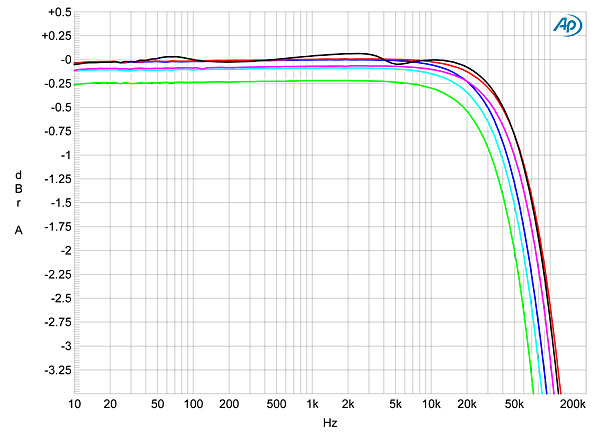
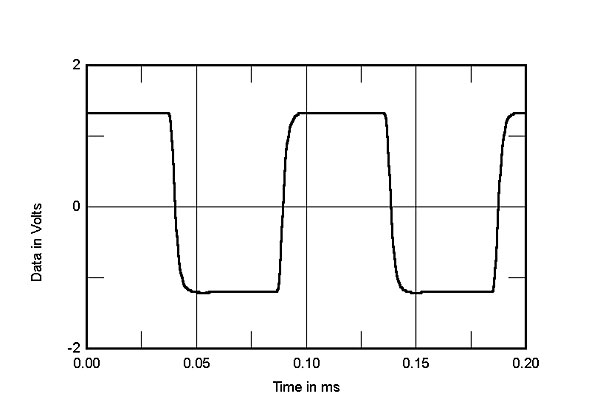
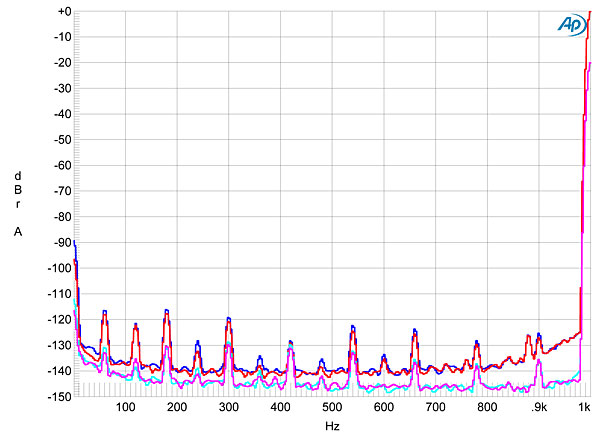
Figs. 4, 5, and 6 show how the percentage of THD+N in the Moon Evolution 860A's output varied with output power into, respectively, 8, 4, and 2 ohms. The downward slope of the traces in these graphs below 10W or so indicates that the actual distortion lies below the already low noise floor at low powers. The gentle rise in THD+N above 10W suggests that the circuit uses only a modest amount of negative feedback, though there is a sharp knee when actual waveform clipping starts to occur.
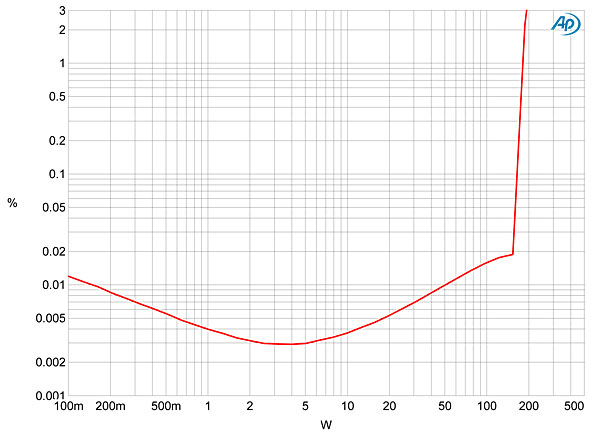
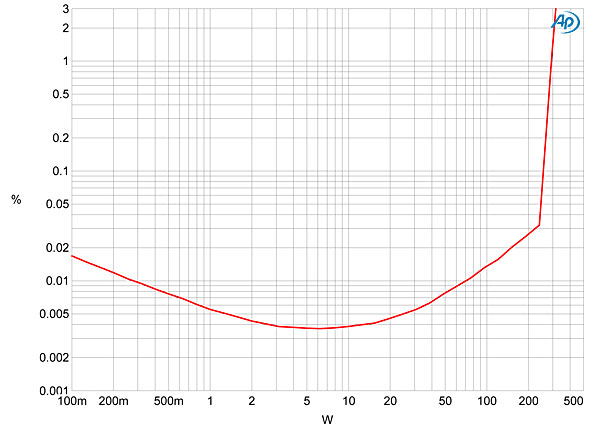
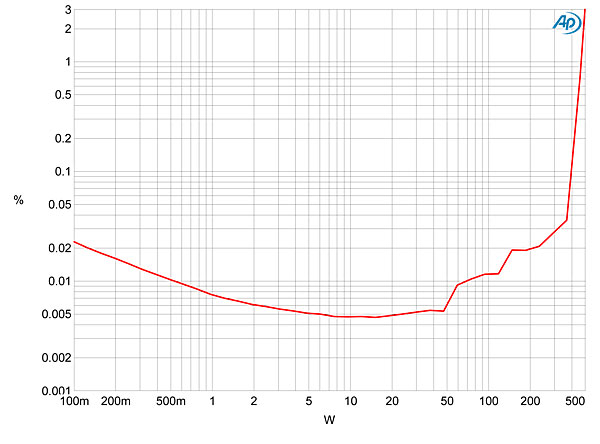
The Moon Evolution 860A is specified as being able to deliver 200Wpc into 8 ohms or 400Wpc into 4 ohms, both powers equivalent to 23dBW. However, figs.4–6 indicate that, with our usual definition of clipping as the power when the THD+N reaches 1%, the Simaudio delivers 180Wpc into 8 ohms (22.55dBW) or 290W into 4 ohms (18.6dBW), both figures taken with both channels driven; or 465W into 2 ohms (20.65dBW), one channel driven. The wall AC voltage was 122.6V with no signal being amplified, and 121.3V at the clipping point into 4 or 2 ohms, so that doesn't explain the slight shortfall in maximum output power. Even so, the Moon Evolution 860A is still a very powerful amplifier.
Measured at 12.67V—equivalent to 20Wpc into 8 ohms, 40Wpc into 4 ohms, or 80W into 2 ohms—the THD+N percentage remained very low into higher impedances, and the rise of THD in the top two octaves was mild (fig.7). The amplifier was clearly less comfortable driving high frequencies at this power level into 2 ohms, though the THD+N remains below 0.1%. The distortion signature, primarily a mix of the second and third harmonics (fig.8), remains low in level even at very high powers into 4 ohms (fig.9). Intermodulation distortion at a level just below visible clipping on the oscilloscope screen was also low (fig.10), the difference component at 1kHz resulting from an equal mix of 19 and 20kHz tones at 200W peak into 4 ohms lying at –86dB (0.006%).
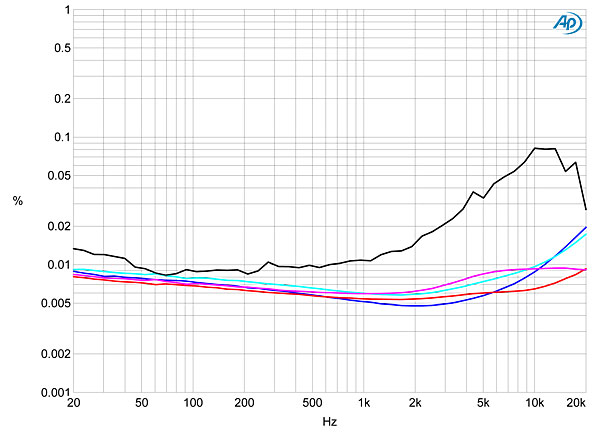
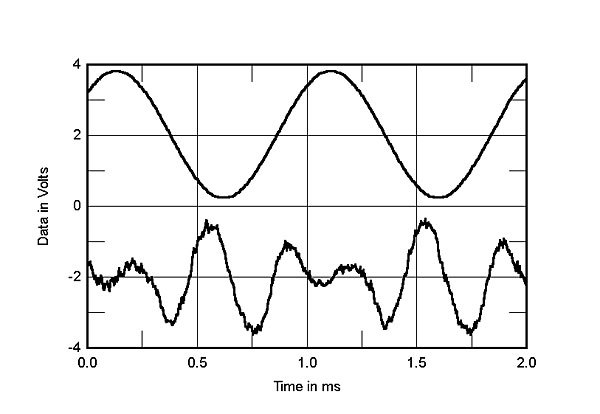
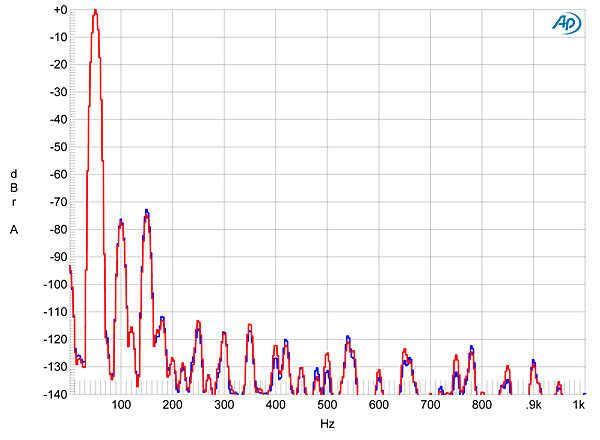
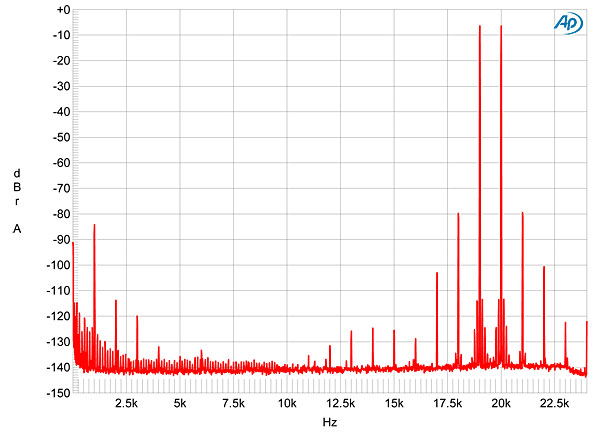
Other than the slight shortfall in maximum power output, the Moon Evolution 860A lives up to Simaudio's reputation for excellent audio engineering.—John Atkinson

And for a fraction of the cost.

The only thing the NAD M3 would blow away (or any NAD product) is its own internals!
NAD stands for shit "Not another defect". Absolutely awful reliability. And, NAD sound quality is nothing special. Cheap hifi sounding.

http://www.stereophile.com/integratedamps/107nad/

You do realize the review in the link is 8 years old?

I don't give a f*ck if Fremer went nuts for the NAD M3. Fremer also claimed the Graham Slee Era V phono stage was miraculous… Good phono stage for its price point, but a little dull. Not the greatest thing ever as Fremer proclaimed.
I have found that NAD gear gets great reviews that do not match with my appraisals when I hear them. I wonder why that is.
The Nad C375BEE was reviewed by Stereophile, and Sam Tellig just about raised a shrine in its honour. I owned it, my brother also owned one. It can be beat easily by British integrateds in the same price bracket. Really easily.
Also, mine lasted 6 months before the front board blew out. My brother was lucky: his lasted 9 months. Good luck with NAD repairs under warranty. They outsource those repairs to local repairmen. Anyone with a multimeter and a screwdriver in your area will be the NAD repairman!
Keep pushing NAD, and I will tell stories of products with 100% failure rates and so on. I know a few former NAD dealers. There is a reason they don't sell NAD anymore...

Although I'm late in chiming in dcolak... I've owned NAD amps way back when I was just a budding audiophile that could only afford entry level gear. Today, NAD is way far back in the rearview mirror. I now own more reference-standard amps such as McIntosh, Classe and Simaudio. Simply no comparison.

I have not heard this particular amp but back when i was living in Montreal a friend owned a W5 amp from Moon and I was really impressed with it, over the years have heard their gear at different shows and actually own some of their products (dac and phono preamp) and absolutely love them. I lament the price increases with each new model but c'est la vie. I have over the years owned different NAD products, not the M3 but have heard the M3 at retail outlets. Great amp but I would have to believe that long term satisfaction would be had with the Moon.

To suppose that the injection of a 1 kHz signal into a power amplifier tells you something very important is ludicrous. I recently compared a new Parasound amplifier to my own 15 year old Moon W-5. I preferred the W-5 for many reasons, one of which was its apparent greater bass output and control. The W-5 was rated at 190 Watts, the Parasound at 250 Watts. But the Moon W-5 has almost twice the transformer capacity and more than twice the power capacitance compared to the Parasound. That matters more than these spurious output measurements.

I'm surprised Simaudio chose not to add a manufacturer's comment to address the measured twenty watt/channel shortfall.
Exaggerated claims of power output in the 1970s are why the FTC clamped down and established procedures for amp ratings, but there's no way of getting around the fact that at least the 860 tested did not provide the power advertised, and it would be good to know whether the sample was defective or if the defect lies in the printed specs.

Fifteen years ago, while walking along the streets of Barcelona, I chanced upon a second hand shop called Cash Converters. As noted, CC gave a fixed amount of cash for goods in reasonable condition, from almond crackers to zebra-striped ashtrays. Therein, I saw a tiny Nad Integrated Amp designated 310. Offering a mere 20 watts aside into 8 ohms, the 310 features a dual channel single-ended driver stage powering a complimentary set of output transistors - one N channel MOSFET and the other a "state-of-the-art" PNP biopolar transistor, a toroidal transformer, and tone controls whose effect are progressively diminished as the volume is advanced. As noted by another reviewer, the simplicity of this design results in a 20% reduction of components, a feature once marketed by NAD as "Super Simple Circuity." While this little Nad quickly falters with hard rock or complex orchestral works, the simplicity of its design delivers, with limpid musical grace, the profound pleasures to be found in well-recorded jazz trios and chamber music - all for the astounding price of sixty euros. Except for brief vacations, I have never shut off my NaD 310 in 15 years, and it has never done anything but recreate the musical events I enjoy with very little artifice and not so much as a hiccup of a technical problem. Over the years, capacitors have been replaced, and I have decent interconnects, and my Audioquest Crystal Cables are connected to a second hand pair of Acoustic Energy Aegis bookshelf speakers, also bought at CC for 150 euros. For 210 euros (and remnant interconnects from a once lavish system before my family came into being) I can still be transported to audio nirvana. What gets one there is to be cherished ... So, in the late night hours, I am very thankful for having this tiny Nad in our apartment ... Listening to good music depends not so much on dollars spent as time enjoyed ... This Nad is far from bad ...